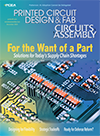Features Articles

And does your purchasing department know what to send, and what not to?
Many commercial EMS and OEM companies have a gaping hole in the system to protect the intellectual property (IP) of their customers.
I can’t count the number of emails from customers requesting a quote for a printed circuit board that include not only the Gerber file(s) for that PCB, but also the assembly drawing, the bill of materials, and the schematic drawing for the entire product.
Companies in our industry take a number of steps to protect customer IP. They require signed nondisclosure agreements for all involved in the manufacture of their PCBs. They verify the identity of any visitors to their secured US manufacturing facilities and assign outsiders mandatory escorts. They may ban cellphones or any other devices that could be used to record inside those facilities.
However, with a press of the Send button, all that IP protection goes out the door.

Changes in materials and components mean yesterday’s issues are also today’s.
Industry is much like the classic Bill Murray movie Groundhog Day: We work on a technical challenge, solve it, and wake up the next day and solve it again.
A recent industry gathering offered such an example. The subject was profiling ovens used in the assembly of circuit boards. Over my decades-long career I have seen dozens of presentations on that very subject. Each time the challenge was the same: new solder materials, laminate or components require tighter and more-defined performance from the oven; thus, the oven must be profiled with ever-greater accuracy and precision.
This recurring phenomenon is not unique to the PCB industry. The original automotive engineers worked on how to make a car accelerate and brake faster, just as their successors do today. The materials, control technologies and performance demands may change, but the recurring engineering challenge is there, whether it’s for an auto braking system or wave solder process.

This year marks the start of my fourth decade in the electronics industry, and if you find that hard to believe, well, so do I.
I was reminiscing with a couple of other “old-timers” in recent weeks over the changes that have occurred since I first stepped foot in a factory. I was a graduate of the University of Illinois, and recently relocated to Chicago, when I joined a few others on a tour of the just-revamped Allen-Bradley plant on Second St. in Milwaukee.
Who remembers any of these names: deHaart. HTI. Conceptronic. Dynapert. Sensbey. Celmacs. Those were some of the bigger names in assembly equipment at the time. Many key suppliers then were subsidiaries of end-product OEMs. Kester was owned by Litton. Dynapert was a unit of Black & Decker.
Forget “lights-out” manufacturing. Even “hands-free” was more theory than reality. Semiautomatic machines, including printers and even placement, were common. DEK had just launched the programmable automatic printer it called the 265. What we now call solder paste was in some circles referred to as solder cream. In those days, as many equipment vendors made IR reflow as forced convention.

FPGAs are a multibillion-dollar business, characterized by suppliers like Xilinx, MicroChip, Texas Instruments and Cypress Semiconductor. So why are they reliant on a single source for copper-wrapped solder column attachment?
And not just any source. Six Sigma is a small, founder-run Silicon Valley-based company. For more than 30 years, it has performed a variety of third-party services, including solder dipping, BGA reballing, and solderability testing. It also happens to be the sole supplier of copper-wrapped solder column attachment services to the major FPGA vendors. And according to industry watchers, that leaves the supply chain in something of a pickle.
The risk with any sole source is something happens that affects their ability to make deliveries. Such an outcome would spell disaster for the high-rel companies that use column grid arrays (CGAs). And loss of access to the unique copper-wrapped columns used in key programs, including military and space, would put those applications at severe risk.

As veteran engineers know, sometimes less is more, and a lot faster.
Our industry is noted for spectacular new technology that eclipses everything around it at breathtaking speed. As exciting and noteworthy as those technologies may seem, however, success more often moves in ways and at speeds akin to the proverbial turtle. Patience pays.
The virtue of patience struck me while attending a regional industry event. The afternoon included technical presentations and a tour of an advanced manufacturing facility. The tour was conducted by energetic, sharp, intelligent young engineers who were excited and proud to show off the fruits of their labors. The facility did not have the latest equipment, but these innovative young bucks set up the equipment to take full advantage of the latest in holistic ergonomic advances, lean material logistics, and had a connected digital ecosystem that would make any Industry 4.0 proponent proud.

Automation and faster amortization should mean lower costs.
PCB manufacturers often include nonrecurring engineering (NRE) and electrical test (ET) charges in quotes, in addition to the piece price. During my training sessions for board buyers, I am frequently asked how to avoid those charges.
It’s a good question.
When I started in this industry some – ahem – 30 years ago, NRE charges were approximately $100 per conductive layer, meaning a 4-layer PCB was $400; a 6-layer PCB was $600, and so on. Back then, it took a lot of labor hours to create manufacturing files from a piece of original artwork, as nothing was as digital as it is today.


